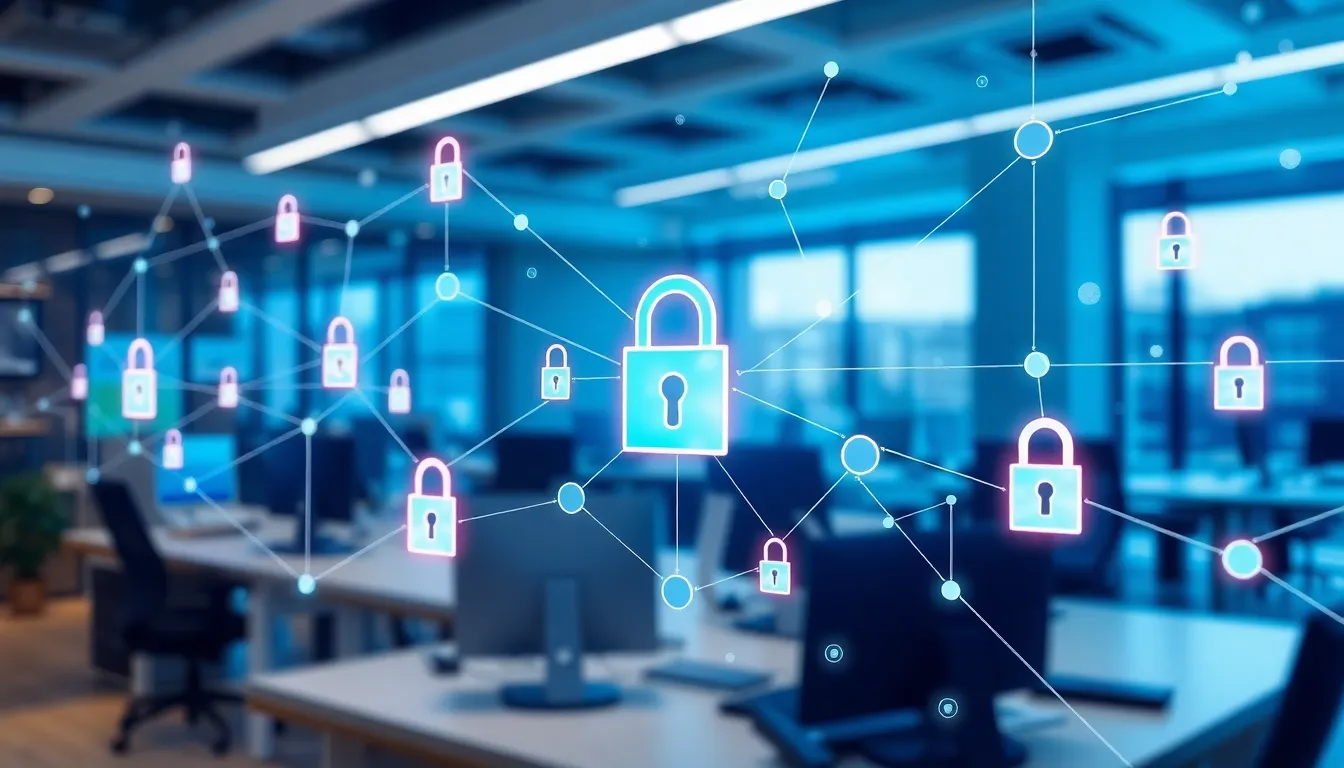Table of Contents
ToggleIn a world where data breaches feel as common as a bad hair day, the intersection of blockchain and cybersecurity is like finding a unicorn in a sea of ordinary horses. This revolutionary technology isn’t just about cryptocurrencies; it’s a game-changer for securing sensitive information. Imagine a fortress built of code, where every transaction is a brick, and hackers can’t even get a foot in the door.
Overview of Blockchain Technology
Blockchain technology offers a decentralized ledger that enhances transparency and security. This innovative system allows multiple parties to access and verify the same information, reducing the risk of manipulation or fraud. Each transaction recorded on a blockchain becomes an irreversible part of the database, ensuring all data remains tamper-proof.
Data blocks link sequentially, creating a chain where every entry contains a cryptographic hash of the previous block. This feature prevents unauthorized changes and bolsters confidence in data integrity. Various industries leverage blockchain’s capabilities, recognizing its potential beyond cryptocurrency applications.
Smart contracts represent another significant aspect of blockchain. These self-executing contracts trigger actions based on predetermined conditions, automating processes and minimizing human intervention. Businesses benefit from increased efficiency and reduced operational costs through this innovation.
Security remains paramount in the digital age. Blockchain’s distributed nature makes it resilient against cyberattacks, as compromising the network requires altering all copies of the ledger simultaneously. This decentralized approach enhances resilience, providing an extra layer of protection against data breaches.
Stakeholders in various sectors, including finance, healthcare, and supply chain management, are adopting blockchain to safeguard sensitive information. A clear understanding of blockchain fosters trust among users, as it offers a transparent and secure method for handling data. As technology continues to advance, its role in cybersecurity becomes increasingly vital.
The Intersection of Blockchain and Cybersecurity

Blockchain technology plays a crucial role in enhancing cybersecurity through its innovative features. It mitigates risks associated with data breaches by ensuring that transactions remain secure and transparent.
Enhanced Security Features
Security features inherent in blockchain technology include encryption, cryptographic hashes, and public-private key pairs. Each transaction undergoes encryption, which prevents unauthorized access to sensitive data. Cryptographic hashes link individual blocks within the blockchain, creating a chain that is incredibly difficult to alter. This process ensures that any change in one block would be evident in subsequent blocks, thereby maintaining data integrity. Public-private key pairs allow users to sign transactions and authenticate identity securely, further protecting against identity theft and fraud. As a result, organizations find that these combined features create a virtually tamper-proof environment.
Decentralization Benefits
Decentralization significantly enhances cybersecurity capabilities within blockchain systems. The distributed nature of blockchain means that no single entity controls the entire network. Consequently, hackers face challenges when attempting to compromise the system, as they would need to alter every copy of the ledger simultaneously. This redundancy minimizes vulnerabilities seen in traditional centralized systems. Organizations in various sectors, such as finance and healthcare, recognize the advantage of distributed ledgers, as they foster trust among participants. Furthermore, leveraging decentralization helps in maintaining uptime and operational efficiency even during attacks, ensuring continuous access to critical data.
Common Cybersecurity Threats
Several cybersecurity threats persist in the digital landscape, posing risks to data security and integrity. Awareness of these threats is essential for effective prevention strategies.
Malware and Ransomware
Malware encompasses malicious software designed to disrupt, damage, or gain unauthorized access to systems. Ransomware, a specific type of malware, encrypts files and demands payment for decryption. In 2021, ransomware attacks increased by 151 percent, impacting businesses worldwide. These threats often originate from phishing attempts or security vulnerabilities, making proactive defenses crucial. Regularly updating antivirus software and implementing robust security protocols can mitigate risks associated with these malicious attacks.
Phishing Attacks
Phishing attacks employ deceptive emails or messages to trick individuals into revealing sensitive information. Techniques vary, including fraudulent requests for payment or login credentials. In fact, phishing attacks accounted for over 80 percent of reported cybersecurity incidents in 2020. Users often fall victim due to convincing impersonation of trusted entities. Employing multi-factor authentication and educating employees about recognizing phishing attempts strengthens defenses against these pervasive threats. Staying vigilant helps organizations protect valuable information and maintain system integrity.
Applications of Blockchain in Cybersecurity
Blockchain technology offers multiple applications that significantly bolster cybersecurity measures across various sectors.
Identity Management
Identity management benefits immensely from blockchain’s decentralized nature. By storing user identities on a blockchain, organizations enhance security and accessibility for sensitive information. Each user’s identity becomes a unique digital asset, protected by encryption and cryptographic hashes. This structure enables efficient verification processes while reducing the risks associated with data breaches and identity theft. Implementations of blockchain-based identity solutions promote trust between users and service providers since individuals maintain control over their personal information. Strikingly, the adoption of such systems can mitigate the challenges posed by centralized identity management, which often leads to vulnerabilities.
Secure Transactions
Secure transactions represent another critical application of blockchain in cybersecurity. Each transaction recorded on a blockchain is immutable, creating a permanent and transparent digital ledger. This transparency ensures accountability, deterring fraudulent activities. By utilizing public-private key pairs, blockchain technology encrypts transaction data, safeguarding it against unauthorized access and tampering. Organizations across finance, healthcare, and supply chains leverage this heightened security to process sensitive data confidently. Remarkably, smart contracts automate transaction agreements. Automating these processes minimizes errors and enhances operational efficiency while bolstering security measures that prevent cyber threats.
Challenges and Limitations
Blockchain technology faces significant challenges and limitations despite its potential to enhance cybersecurity.
Scalability Issues
Scalability remains a critical concern for blockchain networks. As transaction volumes increase, the time and resources required for processing can escalate, causing delays. Ethereum and Bitcoin, for instance, experience slow transaction speeds during peak usage. Such inefficiencies could deter businesses from adopting blockchain solutions. Enterprises often require high throughput and low latency for everyday operations. Addressing these challenges necessitates ongoing development of solutions like sharding and layer-two protocols. They aim to improve scalability and accommodate larger volumes of transactions efficiently.
Regulatory Concerns
Regulatory concerns pose substantial challenges for blockchain implementation. Governments around the world grapple with how to regulate decentralized systems effectively. Unclear regulations can result in hesitancy among businesses that seek to integrate blockchain technology. Financial institutions and healthcare organizations, in particular, must navigate complex compliance landscapes. Privacy regulations like GDPR create additional pressure, as blockchain’s transparency can conflict with data protection requirements. Clear guidance from regulatory bodies is essential for promoting blockchain adoption while ensuring user rights and data security.
Blockchain technology is poised to revolutionize cybersecurity by providing robust solutions to protect sensitive data. Its decentralized nature enhances transparency and minimizes vulnerabilities associated with traditional systems. As organizations across various sectors adopt blockchain, they can foster trust and ensure data integrity.
While challenges like scalability and regulatory concerns remain, ongoing advancements promise to address these issues. The integration of blockchain in identity management and secure transactions highlights its potential to reshape how businesses handle cybersecurity. As digital threats continue to evolve, embracing blockchain could be essential for maintaining security and resilience in an increasingly interconnected world.





